
Hybrid App Development
With the increase in mobile phone usage, practically all businesses must develop a mobile application. Therefore, selecting between native and hybrid mobile apps is one of the most important things to consider.
However, due to the abundance of mobile applications in the market, it can be difficult to understand what exactly makes hybrid apps stand out. How do they compare to native applications regarding performance and user experience? What benefits do they bring to the table?
If you are stuck here, don’t worry. Dive deeper into this article to explore the world of hybrid apps.
Table of Contents
Understanding Hybrid app development

A software program that incorporates features from both native and web apps is called a hybrid application. In essence, hybrid apps are online applications with a native app shell. Once users download and install the application locally from an app store, it connects to the mobile platform’s capabilities through an integrated browser.
Hybrid apps are popular because they let developers write code for a mobile application only once while still supporting many platforms.
Hybrid applications may operate marginally slower than native or web versions of the same software because they impose an additional layer between the source code and the target platform.
Moreover, this application comes with various features, such as
- Independent operations on the devices;
- Interact with the mobile device’s file system.
- Web-based services and an inbuilt browser for accessing dynamic online material.
How to build a hybrid app?
Developing a hybrid mobile app combines native features with web technology. So, let’s examine each step involved in creating a hybrid application.
Organizing
The first step in developing any app is determining whether this system is appropriate. Once you choose an app, plan and organize its features for seamless development. In addition, you need to select appropriate tech stacks to construct the program.
Creating the interface/architecture
One of the most critical phases of any Software Development Life Cycle (SDLC) is the design phase. At this phase, the development team analyzes the business requirements and creates a thorough product architecture with feedback from stakeholders.
Progress
Once you have decided on the features and design of your app, the next step is writing the code to build a fast, reliable, and secure backend. Additionally, designing a visually appealing user interface is another task for this stage.
Examining and troubleshooting
The developers must test the code after it has been written to make sure the app functions and appears as intended in the initial phase. It entails debugging and testing the front and back ends.
Implementation
This step completes the building of your hybrid mobile app. The application must be launched across many platforms and enabled for people to download and install it on their devices.
Maintenance
After it is deployed, your hybrid app needs maintenance, such as bug fixes and routine updates. It assists you in introducing new features and delivering a first-rate user experience. To keep one step ahead of your rivals, you must also use the latest technology and adhere to the most recent trends in hybrid app development.
Cost of Developing a Hybrid App

The cost of hybrid app development is affected by the time required to create the app, its functionality, and its design. Therefore, let’s examine the approximate cost of hybrid mobile apps with varying levels of complexity:
- Simple hybrid mobile apps require simple app features and functionality. Thus, its approximate cost is up to $10,000.
- Medium-complex hybrid mobile apps can cost anything from $10,000 to $50,000 and are more complicated than basic ones. Due to its complex features, it usually takes up to 2 to 3 months.
- Highly complex hybrid mobile apps take longer to design because they are more complicated. They can cost between $50,000 and $150,000 and take three to six months to deploy.
Note that the most demanding apps to create are gaming apps. Due to its highly complex features, you must pay up to $250,000 for its development.
Native Vs Hybrid App
Developing mobile applications requires a substantial financial and time commitment. Thus, when choosing your approach for creating a new mobile application, you must decide between native and hybrid apps. Taking into account the target audience, budget, schedule, and complexity of the project, in order to choose the best solution for your mobile application.
Nonetheless, let’s examine the distinctions between native and hybrid mobile app development.
Native apps are designed to run on a particular platform (e.g., Android, iOS from Apple).
Developers should use programming languages that are compatible with the platform’s operating system.
Because it helps developers improve app speed, security, and functionality; however, the most significant disadvantage of native apps is their high development and maintenance expenses.
In addition, with hybrid app development, you only need to write one line of code and have it run on several different platforms, including Windows, iOS, and Android.
Writing a larger codebase is necessary to develop hybrid apps to ensure compatibility with various operating systems and their versions. Moreover, because you only need to work with one codebase, these apps prove to be highly cost effective in terms of development and maintenance.
Pros Of Hybrid App Development
Due to the ability to launch apps on all major platforms concurrently, hybrid app development is advantageous for businesses, particularly startups. Here are a few advantages of developing a hybrid app.
Inexpensive
Typically, a startup develops an application for one platform without considering the possibility that it would eventually need to run on many platforms. This is a costly error because additional code must be written afterwards. As a result, the company needs to spend money, time, and resources hiring engineers and researching new libraries, APIs, and other things.
Thus, hybrid app development is helpful in situations like these. Creating a single “hybrid” software that runs on multiple platforms is more economical than creating separate app versions for each device. The procedure is undoubtedly an asset for startups and small enterprises with tight funds.
A Greater audience
Web or native applications concentrate on a single platform, which means that a company loses out on a significant portion of the profitable user share from other operating systems.
Focusing only on a particular audience in today’s competitive market can slow expansion. Therefore, Hybrid app development is helpful in these circumstances.
With Android holding a 73 per cent market share and iOS holding a 26 per cent share worldwide, the combined share is 99 percent. Thus, a hybrid approach may enable you to reach a larger audience.
Improved User Interface/ UX
Many resources are available to enhance hybrid app development’s user interface and overall experience. It attracts a larger audience due to its quicker performance,
Furthermore, efficiency is maintained across all platforms because the same set of features and codes are permitted.
Low Maintenance
The fifth benefit of developing hybrid apps is the ease of maintenance. The disadvantage of creating several versions of an application for each platform is the additional time, money, and resources required. Additionally, it is difficult to manage one app solely. But with just one codebase, hybrid app development solves the issue. It provides quick updating and simple maintenance.
Quicker Development
Thanks to the hybrid app architecture, mobile app developers can reuse a huge amount of the same code, and the development process is substantially faster than that of native apps. In addition, technologies like React Native, Flutter, Ionic, etc., make development super simple.
Increased Speed
Extended code is one of the leading causes of an application’s sluggish performance. Because hybrid app development frameworks are built on reuse principles and less code, they guarantee faster development times.
They also operate at a high speed, even in situations with a lot of traffic, because they are not dependent on network connectivity. Twitter is among the best illustrations of a hybrid application.
Time-saving
The obvious time-saving advantage of hybrid app development is its greatest strength. Because there is just one codebase to focus on, there is no need to find and hire multiple developers, investigate various libraries and APIs, or maintain and update many versions.
Better Assistance Offline
Superior offline support is the ultimate advantage of developing hybrid apps. Users with a steady internet connection and small data plans can also effectively use hybrid apps’ offline functionality. They don’t encounter issues with crashing or poor performance.
Quicker Time to Market
Finally, but just as importantly, hybrid app development saves enormous time because it uses a single codebase to create apps for several platforms. Businesses, particularly startups, can benefit from hybrid app development since it allows them to join the mobile market wave across all leading platforms concurrently.
Cons of Hybrid app development
To understand hybrid app development completely, it is also essential to consider its drawbacks.
Test complexity
Although hybrid programs frequently use native code to use the underlying hardware, they may share a large amount of code between platforms. This could make your test suite more complex, depending on your project.
Not optimal for peak performance
A hybrid framework is not the best choice if you want to create a high-performance game that demands precise graphics.
Because they rely on a native browser, these applications have severe UI problems. Although they are simple to update, a single alteration might cause major problems and malfunctions.
Increased complexity
Hybrid apps, a type of new technology, have smaller user bases, fewer developed platforms, and, in the worst case, no documentation.
Therefore, when you create an app that functions one way on one platform but behaves differently on another, you add complexity to a single codebase that would otherwise be split into many independent codebases. This may result in some more apparent paths.
Not able to use native features
Additionally, you cannot incorporate device functionality into a hybrid app; for example, Apple features like Touch ID would not function in a hybrid environment without a plugin. There is a need to create the plugin if one doesn’t already exist.
Example of Hybrid app development
The rapid growth of new technologies and hybrid app frameworks has allowed huge companies to construct high-performance mobile apps with unique interfaces and functionality.
Here are five well-liked hybrid mobile apps that are available to customers worldwide:
Instagram is the most widely used social networking platform for sharing photos and videos. Thanks to its hybrid design, the software can support an enormous amount of media and offline data. When the app is offline, users can still access its features, media, images, and brief videos.
Uber
The Uber app is a fantastic illustration of hybrid app development in action. Because of its accessible and convenient user interface and simple navigation, it’s likely the most used ridesharing app worldwide.
Gmail
Google shifted from HTML, the previous building language, to HTML 5, offering customers new and improved features and functionalities that improve the user experience. This is the ideal illustration of combining online and native components to make a mobile application work well.
Another hybrid app, Twitter, demonstrates that performance is acceptable for this creation. Millions of people use the social networking app every day, and it can manage enormous volumes of traffic.
A Widespread tool for Hybrid app
Although native apps for iOS and Android are the best since they are tailored for each platform, thanks to advancements in mobile app technology, hybrid app creation is becoming a more practical, time- and money-efficient alternative.
Just like standard web application programming frameworks, hybrid mobile app frameworks facilitate the rapid development of apps. They include code libraries, APIs, and other features to help code your app quicker and simpler.
Note: Although hybrid apps allow developers to leverage their existing talents, working with the platform or framework of choice might present some challenges. Each has its own unique capabilities that require some familiarity to fully utilize. Therefore, make sure the hybrid app developer you choose is familiar with that specific tool’s WebView, plugins, runtime, and code aspects.
The Framework used for Hybrid app
Several frameworks are used while developing hybrid apps, such as
- React Native
- Ionic Framework
- NativeScript
- Quasar
- Kendo UI
- Framework7
- Aurelia
- Onsen UI
- Ext JS
- Axway Appcelerator
- Svelte Native
- Xamarin
How to Choose the Best Hybrid App Development Company?
Now that you understand hybrid apps let’s move toward choosing an Expert.
Technical expertise
Technical expertise and certifications are critical for hybrid mobile app developers. These individuals must apply enormous knowledge of hybrid mobile app development to complete the development process error-free. Note that employing professionals will ensure that the app development process runs as smoothly as possible.
Location
Do you care where your team is located? Do you want to collaborate closely with the creators of hybrid apps? Or are you at ease working with trustworthy outside developers? Consider these queries, as they could be crucial in determining which hybrid app development company is appropriate for you.
Price
Another important factor to consider is the app’s price. Different hybrid app developers charge different amounts. Therefore, establish an appropriate app budget and acquire a pricing quote from possible applicants.
After-Launch Assistance
App development is not only limited to deployment but also requires future assistance. Therefore, it is beneficial to look for a developer who will provide ongoing assistance even after the app is developed.
Final Crux
The cost and time involved in creating mobile applications for every platform are high. Benefits like cost-effectiveness, quicker time to market, and cross-platform compatibility are driving the popularity of hybrid apps.
However, making the appropriate decision when developing your mobile application is essential. Making the right choice is aided by considering variables such as target audience, time, and development costs.
Remember, developing hybrid mobile apps can benefit your company unless you are trying to reach a specific mobile platform demographic. You can obtain nearly the same performance as a native app while saving significant money. So, selecting the ideal development team for your project is the next stage.
Finding skilled engineers is difficult due to the enormous demand, but Onyxtec is here to assist you. Our team of experts are ready to guide you at every stage of app development. With the strong command on application we provide you with high quality application without breaking into your bank. So, what are you waiting for? Contact us now!
FAQ
What distinguishes a hybrid app from a native one?
Hybrid apps are made to run on many operating platforms using the same codebase, whereas native apps are made specifically for one operating system, such as iOS or Android.
What language is most helpful in creating hybrid applications?
Programming languages like HTML, CSS, or JavaScript are typically used to create hybrid applications.




